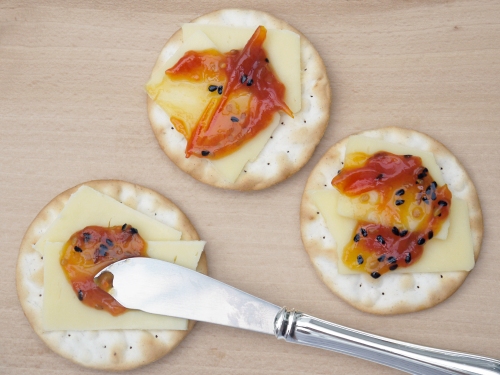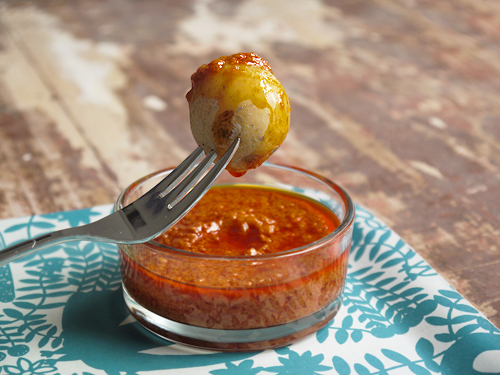Ah, going to Christmas markets! Remember those? Another one of those things we’re not doing this year. To make up for this, I decided to recreate a classic sweet snack you’d find there: the Germans call them Gebrannte Mandeln and we Anglophones would call them caramelised almonds.
I think those almonds you can buy in markets are one of the classic aromas of the festive period, along with mulled wine. There is something about that rich, sweet caramel that just draws you in on a chilly day. In London, you also see pop-up stalls where vendors sell them to passers-by around the tourist hotspots.
So even if we’re not able to go to a pop-up winter village in the city centre and peruse little wooden huts looking at gift ideas, buying treats and tasting dubious liqueurs and spirits, we can still bring a little of that winter fun into the house. I really enjoyed the process of making my batch of Gebrannte Mandeln, popping a few into a paper bag, and then munching them looking at the tree with the Dolly Parton Christmas album blaring. I may or may not have then moved onto a Channel 5 afternoon Christmas movie for some feelgood fun…

They’re not difficult to make, they just need a little patience and a good dash of faith. You make a sugar syrup, then add the nuts and cook them, stirring all the time. Once enough water has evaporated, the sugar suddenly crystallises thanks to your stirring, coating the nuts. You keep on cooking, and the sugar melts and turns to caramel. And that’s your nuts ready! All in all you can do this in 10 minutes, so it’s easy to make if you want something to watch with a movie.
The only tip I have to pass on is to make sure that your vessel is sufficiently deep! I’ve now made these twice, and the first time I used our shallow frying pan. It worked, but it was tricky to keep everything moving without nuts flying out of the pan. I used the deep one for the second batch, and it made life much easier. Everything stayed put, and I could focus on ensuring the sugar was melting evenly and nor burning.
As this is a home-made version, I’ve been able to make the recipe as I like it. I’ve used one part sugar to two parts almonds, so the nuts are lightly coated but now swimming in caramel. You can use more sugar is you want. I’ve also played around with the flavours. You can make Gebrannte Mandeln with just almonds, sugar and water. However, I like the extra festive touch you get from adding some cinnamon, and I love the aroma of the vanilla so that went in too. Finally, a little dash of salt is a good addition as it balances the sweetness and makes for a more complex flavour.

If you want to make a big batch, then go for it. These nuts will keep really well if you put them in an airtight container. If you leave them out, they will get sticky. So as lovely as they look in a bowl or sitting in your grandmother-in-law’s glass bonbonnière, store them properly and transfer them into their lovely vessel when you serve them up. Or pour them into a paper bag, go outside, look at some sparklers and for a brief moment you can feel that Christmas market vibe.
And in the end, I even managed to find a substitute for the Christmas market today. I met up with a neighbour, we each had our mug of mulled win in hand, and – keeping the requisite distance apart – we wandered around the local streets to check out the impressive lights that have been put outside people’s homes this year. There were also a lot of Christmas trees in windows, so plenty for us to look at. It really made me think: the headlines we see are laden with doom and gloom, but even in the middle of all that, there is light and those little moments of joy that we can take pleasure in.
To make Gebrannte Mandeln:
• 200g almonds, skin on
• 100g granulated sugar
• 50ml cold water
• generous pinch of salt
• 1/4 teaspoon ground cinnamon
• 1 teaspoon vanilla extract
1. Put everything except the almonds into a non-stick pot or frying pan. Heat the mixture and bring to the boil, then reduce heat to medium.
2. Once you see large bubbles, add the nuts and start to stir well. At first it will seem like a glossy sticky syrup, but keep heating and stirring, stirring, stirring and eventually the syrup will start to turn white and go grainy. The nuts will be roughly coated in sugar, with some sugar dust in the bottom of the pan.
3. Keep heating the mixture on a medium heat – the sugar will start to melt and caramelise. Keep stirring the nuts so that the caramelisation is even and the nuts toast but don’t burn. Once you’re happy with the state of your nuts, pour them onto a baking sheet lined with greaseproof paper. Use some metal spoons or forks to separate the nuts. Leave to cool completely, then store in an airtight container.










































